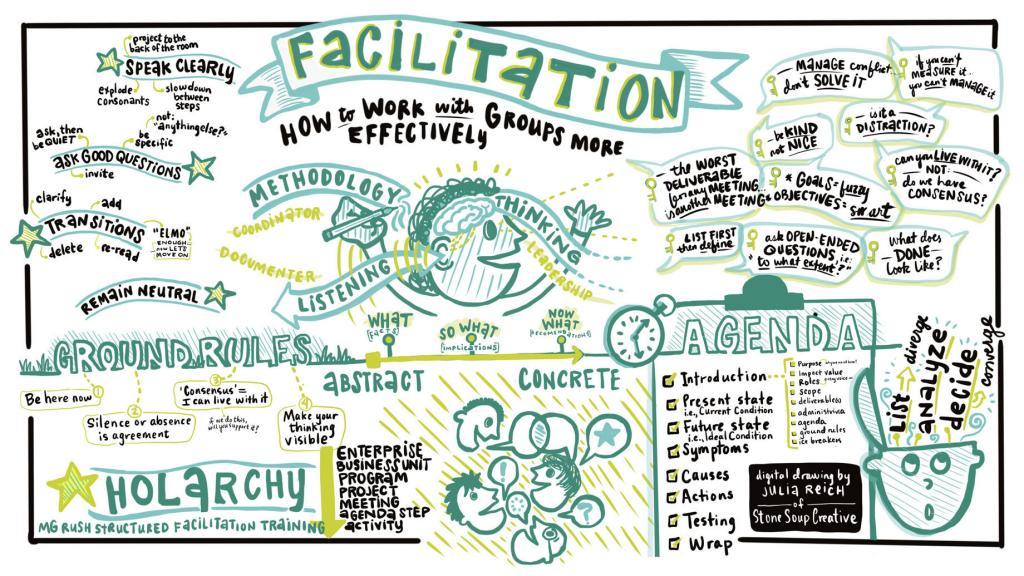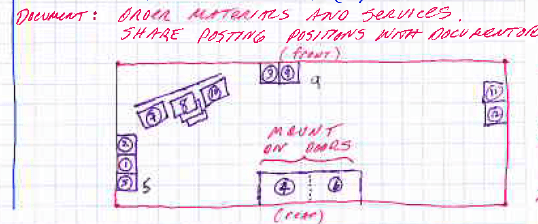Don’t overlook the importance of your meeting documenter or documentation support. The document produced from an MGRUSH workshop provides the raw data for project deliverables. The meeting becomes a waste of time if meeting notes are not clear and accurate.
During lengthy, critical, and modeling workshops, you should solicit support to help with your documentation. It is important that your meeting documenter knows and agrees to their role, functions, and responsibilities.

Role of Neutrality for a Meeting Documenter
Emphasize to every meeting documenter that they are to remain absolutely neutral—they are part of the methodological team (i.e., context) and are never to interfere with the content during or after sessions.
Co-Facilitating Rotation
If or when co-facilitating, consider sharing roles. Pre-assign select steps to facilitate for each leader. When NOT facilitating, the other person serves as the meeting documenter.
Responsibilities of a Meeting Documenter
The meeting documenter is responsible for ensuring completeness and accuracy. The meeting documenter is also responsible for:
- Ensuring the availability of proper tools and equipment.
- Providing documentation that is properly named, archived, and available for the project team upon completion of the workshop.
- Reading the documentation back to the group for clarification.
- Rehearsing the documentation method before the session.
- Transcribing the documentation with notes, decisions, charts, and matrices from the session.
- The documenter assists the facilitator by capturing participant input that is written on flip charts or whiteboards. Capture photographs of the printed versions to double-check documenter accuracy.
- Use the documenter to hang completed flip chart paper on the wall. This helps you to keep the session moving without distractions. Arrange before the workshop where you expect to hang different sections or deliverables within the agenda.
- When the group develops a definition or major decision during the session, ensure information is accurately and fully captured.
- It is important to note that the documenter copies what the session leader writes onto flip charts, a front wall, or overheads. The documenter does not interpret the discussion, capture complete transcription, or capture random notes.
- The documenter does not judge or evaluate what the group decides. If what they are hearing is unclear, the documenter must ask the session leader to ask the group for clarification and not intervene directly.
Who Makes the Best Meeting Documenter?
A meeting documenter should be easy to work with, willing to keep quiet (i.e., follow the role of content neutrality), have good handwriting, understand the situational terminology, be willing to work for you during the session, and understand the purpose and deliverable of the structured meeting notes. Good documenters can be found typically in three places:

Meeting Documenter
- Trained session leaders frequently make strong documenters. Supporting one another and experience numerous benefits from cross-training, especially for newer facilitators.
- Project members from other, especially related projects. These people understand the terminology and how notes get used (e.g., input to requirements or design specs). They must be chosen carefully because they need to remain quiet and cannot become involved in the discussions.
- New hire trainees or interns provide a win-win opportunity. These people tend to work hard at being good documenters. They frequently have enough background in terminology that they do not get lost in the discussions.
- For purely narrative capture, administrative assistants will work wonders because you have removed them from more mundane activities.
Plan Your Work, Work Your Plan
The relationship between you and the documenter is important because the session leader and documenter comprise the methodological team responsible for generating the final deliverable. Optimally, constant communication between you is essential. Keep the following in mind when working with a documenter:
How to Train Documenters?
The following steps provide a method for training documenters:
- Provide them with a copy of your annotated agenda. Walk through each of the agenda steps, their role, the volume of documentation you expect, and what to do with it. Provide them with examples from prior workshops or deliverables to illustrate how their captured input will be used. Examples can be from previous sessions or created by the session leader, preferably relying upon a metaphor or analogy.
- Documenters often feel intimidated when they see a bunch of templates and do not understand their purpose. Explain the purpose of the deliverables from each question you intend to ask in the workshop. Your MGRUSH Reference Manual includes descriptions of the deliverables from each step in the workshop of the Cookbook Agendas. Your note-taking tools should not get in the way of documentation. Let them modify the format of note-taking if it is appropriate.
- Develop a picture of the final deliverable of the workshop. You can use simple flow-chart or templates or arrows and icons to represent the final document structure. This helps the documenter to move the note-taking out of the abstract into something concrete.
- Walk through the technique and methods with the documenter prior to the session to ensure that that their role is clearly understood—address any questions they have.
- Training does not end with the start of the workshop. During the workshop, check with the documenter often to ensure that there are no problems and that the appropriate outputs are being properly documented.
Checklist for Meeting Documenters
Use this checklist with your documenter to prepare and review.
- Sit where you can see and hear the session leader and what the session leader is writing on visual aids. Preferably, position yourself on the U-shaped table close to the facilitator.
- Have all materials ready before the workshop starts.
- Clear your work area from any distractions.
- Neat handwriting is necessary if you are handwriting.
- Listen to, understand, and be alert for key ideas.
- Give speakers and session leaders careful attention. Do not change meanings to your own. Document the main ideas; the essence of the discussion as taken from the flip charts or other visuals that the session leader is using. Capture the results from the visuals—not complete transcriptions or word by word minutes of the meeting.
- Capture information first—grammar and punctuation later.
- Avoid abbreviations, key, or cue words. Do not change words or meaning.
- Stick to verbatim comments whenever possible.
- Accurately and fully capture the ideas, workflows, outputs, and other components of any models or matrices that are built.
- Seek clarification and review as soon as possible if unsure. Remember—if not documented, it did not happen!
- Control your emotions. If you are reacting to your surroundings or a group member, you cannot listen effectively.
- Stay out of the discussion. Stick to your role. Stay neutral!
Meeting Documenters’ Guidelines
Once you have the right tool and the right documenter, use them properly.
- Always take photographs of handwritten sheets as a back-up.
- Do not attempt to capture documentation real time with the screen displayed to the participants (eg, using a large screen projector hooked up to the terminal). This distracts the participants from the purpose of the meeting (they become enamored with the tool), it forces a low-light condition (which may put some people to sleep), and any mistake, confusion, or slowness of capture is both visible and out of your control (the documenter is doing it).
- Capture process flows or screen layouts and shows them to the participants. First, the session leader draws them on a whiteboard, flip chart, or another manual tool. The documenter captures the layout on a prototyping or mockup tool. When possible, project the finished illustration, diagram, or report on a large screen. If not, take a photograph of the original to re-create offline.
- If you are using a modeling tool (eg, VISIO), have the documenter run the analysis routines during breaks, lunch, or in the evening. Use the results to develop questions for the workshop to ensure completeness before the end of the workshop. Take advantage of the analysis capabilities of the tool, but do not run the analysis with the participants waiting for you to finish.
- Make certain that adequate backup is provided (both software copies and manual backup to cover the period of time since the last copy was made). Automated tools sometimes crash, or electricity sometimes goes out. Do not be caught losing documentation.
______
Don’t ruin your career by hosting bad meetings. Sign up for a workshop or send this to someone who should. MGRUSH workshops focus on meeting design and practice. Each person practices tools, methods, and activities daily during the week. Therefore, while some call this immersion, we call it the road to building high-value facilitation skills.
Our workshops also provide a superb way to earn up to 40 SEUs from the Scrum Alliance, 40 CDUs from IIBA, 40 Continuous Learning Points (CLPs) based on Federal Acquisition Certification Continuous Professional Learning Requirements using Training and Education activities, 40 Professional Development Units (PDUs) from SAVE International, as well as 4.0 CEUs for other professions. (See workshop and Reference Manual descriptions for details.)
Want a free 10-minute break timer? Sign up for our once-monthly newsletter HERE and receive a free timer along with four other of our favorite facilitation tools.

Terrence Metz, MBA, CSM, CSPF, PSP01, HTTO1, is the Managing Director of MG RUSH Facilitation Leadership, Training, and Meeting Design, an acknowledged leader in structured facilitation training, and author of “Meetings That Get Results – A Facilitator’s Guide to Building Better Meetings.” His FAST Facilitation Best Practices blog features nearly 300 articles on facilitation skills and tools aimed at helping others lead meetings that produce clear and actionable results. His clients include Agilists, Scrum teams, program and project managers, senior officers, and the business analyst community among numerous private and public companies and global corporations. As an undergraduate of Northwestern University (Evanston, IL) and an MBA graduate from NWU’s Kellogg School of Management, his professional experience has focused on process improvement and product development. He continually aspires to make it easier for others to succeed.

